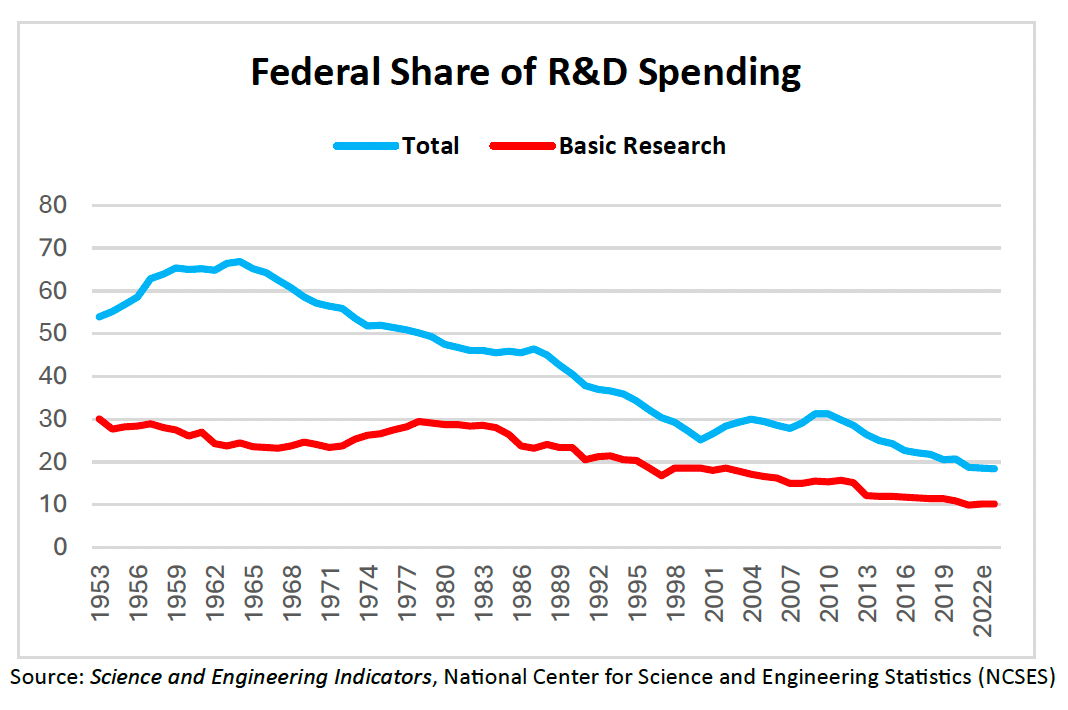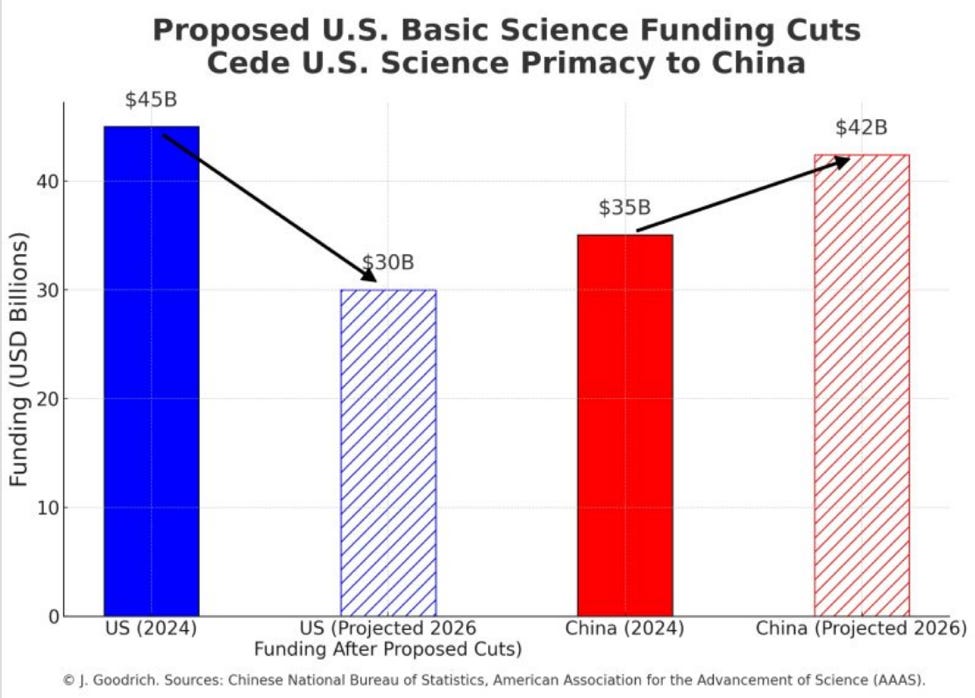The Basic Research Race
Shockingly, China has taken the lead from the US in government-supported basic research.
What do Herbert Simon, Alan Turing, and Geoffrey Hinton have in common? They were (or still are in the case of Hinton) renowned scientists, focused on abstract theoretical research that had little or no immediate commercial payback. And yet without Simon’s work on cognitive technology, Turing’s theory of computation, and Hinton’s research on neural networks, artificial intelligence might never have come to pass.
These are just a few of the countess examples of basic research as a fundamental building bloc of innovation and technological revolutions, ultimately the essence of global competitive leadership. All three of these pathbreaking scientists benefited from governmental support of their research — Simon in the US, Turing and Hinton in the UK. The role of the government in supporting basic research is critical. In “normal” times — not easy to remember, I know — government stewardship of basic research was a sacred responsibility. Unlike private actors who are motivated, and at times compromised, by commercial returns, government support frees up scientists and other researchers to explore seemingly abstract ideas aimed at pushing the frontiers of knowledge. That’s where this tale has become problematic. The United States now appears to be ceding its long-standing position of global leadership in government funded basic research to China.
This has been a long time coming. Based on official statistics from the National Science Foundation, the blue line in the chart below underscores the declining Federal government share of total US spending on research and development (R&D), which has essentially been on downtrend since the post-Sputnik peak of 1965. The red line draws attention to the key basic research piece of total R&D, where the Federal government’s share has fallen from 30% of the total in the late 1970s to around 10% in 2023 (latest data available). Inasmuch as basic research is very much a collaborative effort — direct funding by the government and university support for project execution — US budgetary and political pressures have had broad implications for the science-university research complex that lies at the heart of innovation.
This development has taken an ominous twist in the early days of Trump 2.0. An anti-science vendetta, in conjunction with an unprecedented assault on major US research universities, has taken a dramatic toll on America’s basic research primacy. A detailed assessment of R&D recently published by the American Association for the Advancement of Science (AAAS) suggests that total Federally funded basic research is likely to be slashed to just $30 billion in fiscal year 2026, a 34% drop from the $45 billion spending level estimated for fiscal 2025 (Note: the latest official NSF tally of the federal government portion of basic research is $39.6 billion for 2022). Based on NSF metrics, that would take Federal funding of US basic research back to levels last seen in 2002.
The China R&D comparison is even more startling. According to AAAS calculations, the US accounted for 29% of global R&D in 2023, only fractionally greater than China’s 28% share. Convergence was only a matter of time. Over the past ten years, Chinese R&D spending increased at nearly a 14% average annual rate, more than three and a half times the 3.7% pace of the US. Under the conservative assumption that this disparity in growth rates has persisted, US-China convergence of total R&D should have occurred by 2024. Comparable cross-country figures for basic research are not available on a timely basis. But CSIS analyst James Goodrich has taken a stab at updating the comparison (see chart below). Reflecting the draconian cuts in the current Trump policy package noted above, an extrapolation of trend growth in China leads to the utterly staggering conclusion that the US is now in the process of abdicating its long-standing lead in government-supported basic research to China.
It is tempting to give up asking “why?” when it comes to the extreme policy pronouncements of Trump 2.0. The same questions could be raised about tariffs, DEI-related assaults on universities and law firms, dismemberment of the Federal bureaucracy, reversal of climate polices in an era of extreme weather, slashing humanitarian foreign aid programs, and, most recently, attacks on an independent Federal Reserve. It is easy, and in once sense fair, to say that most of these policy reversals were all telegraphed in Project 2025. But that still begs the question of, why? Keep in mind that the leading reform in Chapter 4 (on Defense policy) of that blueprint document was to “champion, engage, and focus the American innovation ecosystem.” The gutting of basic research is anything but that.
The generous interpretation of the anti-science stance of the Trump Administration is that its America First approach to public policy will unshackle a long dynamic private sector that is perfectly capable of standing on its own. Just look at Nvidia, Google, Microsoft, Apple, and Amazon. After all, they have flourished, goes the MAGA argument, while Federal funding for R&D has been under serious pressure for several decades. The hope is that a long overdue shrinkage of big government will further enhance the brilliant successes of America’s most spectacular companies.
Try telling that to Xi Jinping, especially when it comes to the imperatives of basic science. Picking up on the focus of his predecessor, Hu Jintao’s signature efforts at “scientific development,” Xi has long stressed the importance of scientific research as a pillar of Chinese indigenous innovation. He was particularly expansive on the topic during a Politburo study group in early 2023, arguing that, “strengthening basic research is an imperative for higher-level self-reliance, and greater strength in science and technology, and is the only path to building China into a world leader in science and technology.” And now by leapfrogging the US in government funding for basic research, China is well positioned to deliver on that commitment.
All this dovetails with the latest trends in the Global Innovations Index that I discussed in detail last week. As measured by this gauge, China has closed the gap with the Unted States dramatically over the past 15 years — rising from 41st to 11th place in a sample of 130 countries while US has held its own at around 3rd place. Nothing wrong with number three, some might say, especially when the first two (Switzerland and Sweden) are hardly in the same league as the two superpowers. However, the GII is more of a multidimensional snapshot of the global innovations race at a particular point in time. Basic research is the seed corn that drives future trends in innovation, whether they fit into the input or the output sides of the GII framework.
Today’s innovations debate is fixated on the battle between two systems — America’s entrepreneurial, private sector Silicon Valley model and China’s state-directed industrial policy version. Basic research is the greater leveler in this debate. Irrespective of who drives the system – the state or the private sector —innovation ultimately flows from discovery. Genius, a penetrating new book on AI by Henry Kissinger, Craig Mundie, and Eric Schmidt, asserts that “discovery may be the single most exhilarating capacity of the human species.” Basic research, while abstract, theoretical, and lacking in immediate commercial payback, throws out a large net in support of this culture of discovery. The Chinese have known that since ancient times. Sadly, we seem to have forgotten this key lesson from our past, when America was truly great.




On the money!